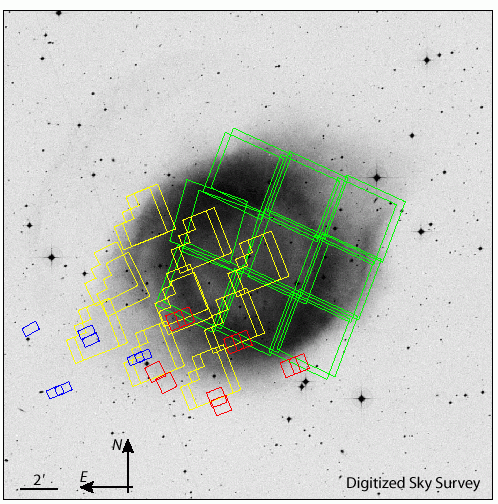|
|||||||||||||||||||
|
|
|||||||||||||||||||
|
The Hubble Helix Observations Observations - Data - Reductions - Images 
|
 For the 14 hours of peak Leonid meteoroid
flux in November 2002, the Hubble Space Telescope
was pointed away from the radiant, and
the solar arrays were oriented to minimize
their cross-section. By coincidence, one of
the nearest and largest planetary nebulae,
the Helix Nebula (NGC 7293), was nearly opposite
the incoming Leonids and could be
observed.
A "Hubble Helix Team" (below) of volunteers led by
Margaret Meixner (STScI) organized a nine-orbit
campaign to observe the Helix with the ACS,
WFPC2, NICMOS, and STIS.
For the 14 hours of peak Leonid meteoroid
flux in November 2002, the Hubble Space Telescope
was pointed away from the radiant, and
the solar arrays were oriented to minimize
their cross-section. By coincidence, one of
the nearest and largest planetary nebulae,
the Helix Nebula (NGC 7293), was nearly opposite
the incoming Leonids and could be
observed.
A "Hubble Helix Team" (below) of volunteers led by
Margaret Meixner (STScI) organized a nine-orbit
campaign to observe the Helix with the ACS,
WFPC2, NICMOS, and STIS.
A contiguous 3x3 grid of 4kx4k-pixel ACS images covering much but not all of the Helix was exposed in two filters, Ha+[N II] (F658N) and [O III] (F502N). The WFPC2 images, obtained in parallel, covered portions of the nebula in [O I] (F631N), He II (F469N), or Ha (F656N). NICMOS/NIC3 observations were obtained at two locations on the nebula and two off NICMOS/NIC3 observations were obtained at five locations on the nebula and four off (not shown). A few of the STIS parallel observations in [O II] (F28X50OII) were located on the nebula, but most were located off the nebula.
Publications
Preliminary results were presented in a poster at the January 2003 AAS Meeting in Seattle. A detailed analysis, including a new color composite image (incorporating CTIO mosaic data), was later published in "Unraveling the Helix Nebula: it's structure and knots" (The Astronomical Journal, 128:2339 2356, 2004 November). Analysis if the NICMOS data was published in "The Multitude of Molecular Hydrogen Knots in the Helix Nebula" (The Astronomical Journal, paper accepted June 2005.This website provides access to data and information intended primarily for scientists and students interested in further scientific analysis of the data. See the 2003 press release, the 2004 press release, and resulting news articles for color images and other information intended primarily for the general public.
Web site contents
- Observations: description of the observing program, and listing of exposures
- Data: Download FITS data for further processing and analysis. Included are some pipeline-processed data, the drizzle-combined mosaics, and some intermediate files from various steps in the processing.
- Reductions: Details on data calibration and reduction; includes drizzling, mosaicking (astrometric registration), and cosmic ray rejection.
- Images: collection of GIF images for easy viewing and comparison, and links to related images and information
The Hubble Helix Team
M. Meixner (Principal Investigator), H.E. Bond, G. Chapman,Y.H. Chu, C. Cox, P. Cox, W. Crothers, L.M. Frattare, R. Gilliland, M. Guerrero, R. Gruendl, F. Hamilton, R. Hook, P. Huggins, I. Jordan, C.D. Keyes, A. Koekemoer, K. Kwitter, Z.G. Levay, P.R. McCullough, M. Mutchler, K. Noll, C.R. O'Dell, N. Panagia, M. Reinhart, M. Robberto, K. Sahu, D. Soderblom, L. Stanghellini, C.Tyler, J.Valenti, A.Welty, and B.Williams
We thank the many people at GSFC and
STScI who schedule and operate the
telescope for making this opportunity
available to the astronomical community.
In particular we thank Keith Kalinowski and
Dave Scheve who approved pointing the
HST at the Helix during the Leonids stand-down period.
|
|
|




 Follow Us
Follow Us